Mengjia Xu
Hierarchical Mamba Meets Hyperbolic Geometry: A New Paradigm for Structured Language Embeddings
May 25, 2025Abstract:Selective state-space models have achieved great success in long-sequence modeling. However, their capacity for language representation, especially in complex hierarchical reasoning tasks, remains underexplored. Most large language models rely on flat Euclidean embeddings, limiting their ability to capture latent hierarchies. To address this limitation, we propose Hierarchical Mamba (HiM), integrating efficient Mamba2 with exponential growth and curved nature of hyperbolic geometry to learn hierarchy-aware language embeddings for deeper linguistic understanding. Mamba2-processed sequences are projected to the Poincare ball (via tangent-based mapping) or Lorentzian manifold (via cosine and sine-based mapping) with "learnable" curvature, optimized with a combined hyperbolic loss. Our HiM model facilitates the capture of relational distances across varying hierarchical levels, enabling effective long-range reasoning. This makes it well-suited for tasks like mixed-hop prediction and multi-hop inference in hierarchical classification. We evaluated our HiM with four linguistic and medical datasets for mixed-hop prediction and multi-hop inference tasks. Experimental results demonstrated that: 1) Both HiM models effectively capture hierarchical relationships for four ontological datasets, surpassing Euclidean baselines. 2) HiM-Poincare captures fine-grained semantic distinctions with higher h-norms, while HiM-Lorentz provides more stable, compact, and hierarchy-preserving embeddings favoring robustness over detail.
A Comparative Study on Dynamic Graph Embedding based on Mamba and Transformers
Dec 15, 2024Abstract:Dynamic graph embedding has emerged as an important technique for modeling complex time-evolving networks across diverse domains. While transformer-based models have shown promise in capturing long-range dependencies in temporal graph data, they face scalability challenges due to quadratic computational complexity. This study presents a comparative analysis of dynamic graph embedding approaches using transformers and the recently proposed Mamba architecture, a state-space model with linear complexity. We introduce three novel models: TransformerG2G augment with graph convolutional networks, DG-Mamba, and GDG-Mamba with graph isomorphism network edge convolutions. Our experiments on multiple benchmark datasets demonstrate that Mamba-based models achieve comparable or superior performance to transformer-based approaches in link prediction tasks while offering significant computational efficiency gains on longer sequences. Notably, DG-Mamba variants consistently outperform transformer-based models on datasets with high temporal variability, such as UCI, Bitcoin, and Reality Mining, while maintaining competitive performance on more stable graphs like SBM. We provide insights into the learned temporal dependencies through analysis of attention weights and state matrices, revealing the models' ability to capture complex temporal patterns. By effectively combining state-space models with graph neural networks, our work addresses key limitations of previous approaches and contributes to the growing body of research on efficient temporal graph representation learning. These findings offer promising directions for scaling dynamic graph embedding to larger, more complex real-world networks, potentially enabling new applications in areas such as social network analysis, financial modeling, and biological system dynamics.
TransformerG2G: Adaptive time-stepping for learning temporal graph embeddings using transformers
Jul 05, 2023



Abstract:Dynamic graph embedding has emerged as a very effective technique for addressing diverse temporal graph analytic tasks (i.e., link prediction, node classification, recommender systems, anomaly detection, and graph generation) in various applications. Such temporal graphs exhibit heterogeneous transient dynamics, varying time intervals, and highly evolving node features throughout their evolution. Hence, incorporating long-range dependencies from the historical graph context plays a crucial role in accurately learning their temporal dynamics. In this paper, we develop a graph embedding model with uncertainty quantification, TransformerG2G, by exploiting the advanced transformer encoder to first learn intermediate node representations from its current state ($t$) and previous context (over timestamps [$t-1, t-l$], $l$ is the length of context). Moreover, we employ two projection layers to generate lower-dimensional multivariate Gaussian distributions as each node's latent embedding at timestamp $t$. We consider diverse benchmarks with varying levels of ``novelty" as measured by the TEA plots. Our experiments demonstrate that the proposed TransformerG2G model outperforms conventional multi-step methods and our prior work (DynG2G) in terms of both link prediction accuracy and computational efficiency, especially for high degree of novelty. Furthermore, the learned time-dependent attention weights across multiple graph snapshots reveal the development of an automatic adaptive time stepping enabled by the transformer. Importantly, by examining the attention weights, we can uncover temporal dependencies, identify influential elements, and gain insights into the complex interactions within the graph structure. For example, we identified a strong correlation between attention weights and node degree at the various stages of the graph topology evolution.
Norm-based Generalization Bounds for Compositionally Sparse Neural Networks
Jan 28, 2023



Abstract:In this paper, we investigate the Rademacher complexity of deep sparse neural networks, where each neuron receives a small number of inputs. We prove generalization bounds for multilayered sparse ReLU neural networks, including convolutional neural networks. These bounds differ from previous ones, as they consider the norms of the convolutional filters instead of the norms of the associated Toeplitz matrices, independently of weight sharing between neurons. As we show theoretically, these bounds may be orders of magnitude better than standard norm-based generalization bounds and empirically, they are almost non-vacuous in estimating generalization in various simple classification problems. Taken together, these results suggest that compositional sparsity of the underlying target function is critical to the success of deep neural networks.
Scalable algorithms for physics-informed neural and graph networks
May 16, 2022



Abstract:Physics-informed machine learning (PIML) has emerged as a promising new approach for simulating complex physical and biological systems that are governed by complex multiscale processes for which some data are also available. In some instances, the objective is to discover part of the hidden physics from the available data, and PIML has been shown to be particularly effective for such problems for which conventional methods may fail. Unlike commercial machine learning where training of deep neural networks requires big data, in PIML big data are not available. Instead, we can train such networks from additional information obtained by employing the physical laws and evaluating them at random points in the space-time domain. Such physics-informed machine learning integrates multimodality and multifidelity data with mathematical models, and implements them using neural networks or graph networks. Here, we review some of the prevailing trends in embedding physics into machine learning, using physics-informed neural networks (PINNs) based primarily on feed-forward neural networks and automatic differentiation. For more complex systems or systems of systems and unstructured data, graph neural networks (GNNs) present some distinct advantages, and here we review how physics-informed learning can be accomplished with GNNs based on graph exterior calculus to construct differential operators; we refer to these architectures as physics-informed graph networks (PIGNs). We present representative examples for both forward and inverse problems and discuss what advances are needed to scale up PINNs, PIGNs and more broadly GNNs for large-scale engineering problems.
DynG2G: An Efficient Stochastic Graph Embedding Method for Temporal Graphs
Sep 28, 2021



Abstract:Dynamic graph embedding has gained great attention recently due to its capability of learning low dimensional graph representations for complex temporal graphs with high accuracy. However, recent advances mostly focus on learning node embeddings as deterministic "vectors" for static graphs yet disregarding the key graph temporal dynamics and the evolving uncertainties associated with node embedding in the latent space. In this work, we propose an efficient stochastic dynamic graph embedding method (DynG2G) that applies an inductive feed-forward encoder trained with node triplet-based contrastive loss. Every node per timestamp is encoded as a time-dependent probabilistic multivariate Gaussian distribution in the latent space, hence we can quantify the node embedding uncertainty on-the-fly. We adopted eight different benchmarks that represent diversity in size (from 96 nodes to 87,626 and from 13,398 edges to 4,870,863) and diversity in dynamics. We demonstrate via extensive experiments on these eight dynamic graph benchmarks that DynG2G achieves new state-of-the-art performance in capturing the underlying temporal node embeddings. We also demonstrate that DynG2G can predict the evolving node embedding uncertainty, which plays a crucial role in quantifying the intrinsic dimensionality of the dynamical system over time. We obtain a universal relation of the optimal embedding dimension, $L_o$, versus the effective dimensionality of uncertainty, $D_u$, and we infer that $L_o=D_u$ for all cases. This implies that the uncertainty quantification approach we employ in the DynG2G correctly captures the intrinsic dimensionality of the dynamics of such evolving graphs despite the diverse nature and composition of the graphs at each timestamp. Moreover, this $L_0 - D_u$ correlation provides a clear path to select adaptively the optimum embedding size at each timestamp by setting $L \ge D_u$.
AOSLO-net: A deep learning-based method for automatic segmentation of retinal microaneurysms from adaptive optics scanning laser ophthalmoscope images
Jun 25, 2021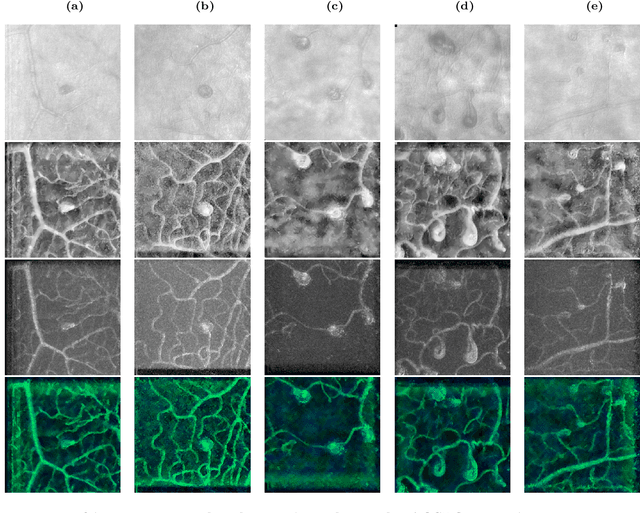
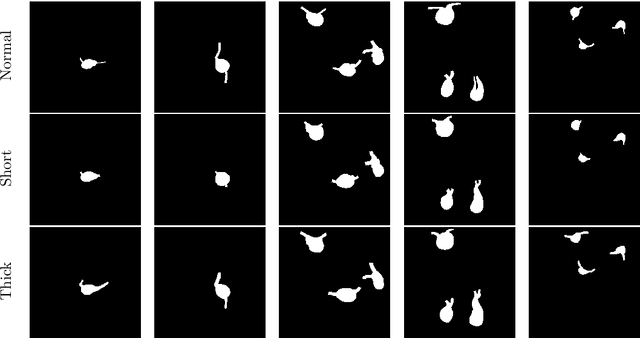
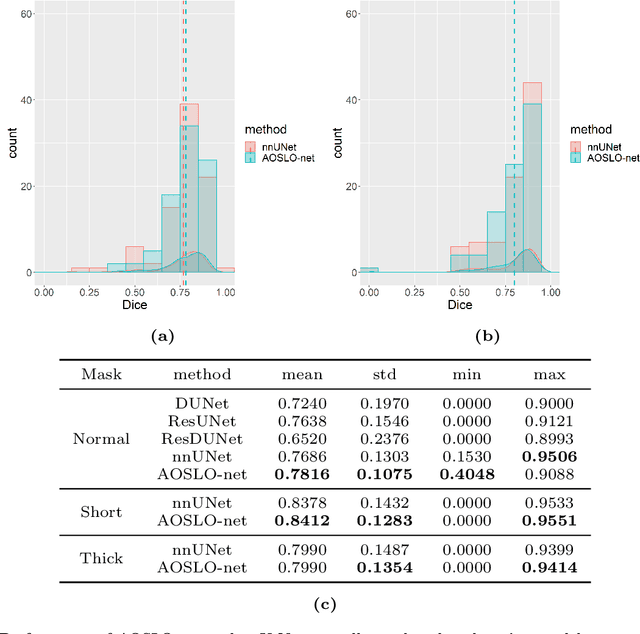
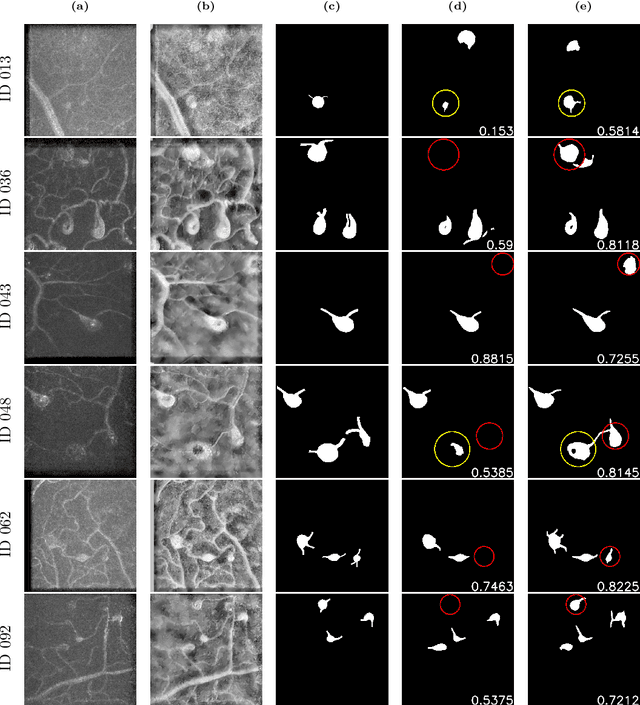
Abstract:Microaneurysms (MAs) are one of the earliest signs of diabetic retinopathy (DR), a frequent complication of diabetes that can lead to visual impairment and blindness. Adaptive optics scanning laser ophthalmoscopy (AOSLO) provides real-time retinal images with resolution down to 2 $\mu m$ and thus allows detection of the morphologies of individual MAs, a potential marker that might dictate MA pathology and affect the progression of DR. In contrast to the numerous automatic models developed for assessing the number of MAs on fundus photographs, currently there is no high throughput image protocol available for automatic analysis of AOSLO photographs. To address this urgency, we introduce AOSLO-net, a deep neural network framework with customized training policies to automatically segment MAs from AOSLO images. We evaluate the performance of AOSLO-net using 87 DR AOSLO images and our results demonstrate that the proposed model outperforms the state-of-the-art segmentation model both in accuracy and cost and enables correct MA morphological classification.
Understanding graph embedding methods and their applications
Dec 15, 2020



Abstract:Graph analytics can lead to better quantitative understanding and control of complex networks, but traditional methods suffer from high computational cost and excessive memory requirements associated with the high-dimensionality and heterogeneous characteristics of industrial size networks. Graph embedding techniques can be effective in converting high-dimensional sparse graphs into low-dimensional, dense and continuous vector spaces, preserving maximally the graph structure properties. Another type of emerging graph embedding employs Gaussian distribution-based graph embedding with important uncertainty estimation. The main goal of graph embedding methods is to pack every node's properties into a vector with a smaller dimension, hence, node similarity in the original complex irregular spaces can be easily quantified in the embedded vector spaces using standard metrics. The generated nonlinear and highly informative graph embeddings in the latent space can be conveniently used to address different downstream graph analytics tasks (e.g., node classification, link prediction, community detection, visualization, etc.). In this Review, we present some fundamental concepts in graph analytics and graph embedding methods, focusing in particular on random walk-based and neural network-based methods. We also discuss the emerging deep learning-based dynamic graph embedding methods. We highlight the distinct advantages of graph embedding methods in four diverse applications, and present implementation details and references to open-source software as well as available databases in the Appendix for the interested readers to start their exploration into graph analytics.
A Graph Gaussian Embedding Method for Predicting Alzheimer's Disease Progression with MEG Brain Networks
May 08, 2020



Abstract:Characterizing the subtle changes of functional brain networks associated with the pathological cascade of Alzheimer's disease (AD) is important for early diagnosis and prediction of disease progression prior to clinical symptoms. We developed a new deep learning method, termed multiple graph Gaussian embedding model (MG2G), which can learn highly informative network features by mapping high-dimensional resting-state brain networks into a low-dimensional latent space. These latent distribution-based embeddings enable a quantitative characterization of subtle and heterogeneous brain connectivity patterns at different regions and can be used as input to traditional classifiers for various downstream graph analytic tasks, such as AD early stage prediction, and statistical evaluation of between-group significant alterations across brain regions. We used MG2G to detect the intrinsic latent dimensionality of MEG brain networks, predict the progression of patients with mild cognitive impairment (MCI) to AD, and identify brain regions with network alterations related to MCI.
Multi-label Detection and Classification of Red Blood Cells in Microscopic Images
Oct 07, 2019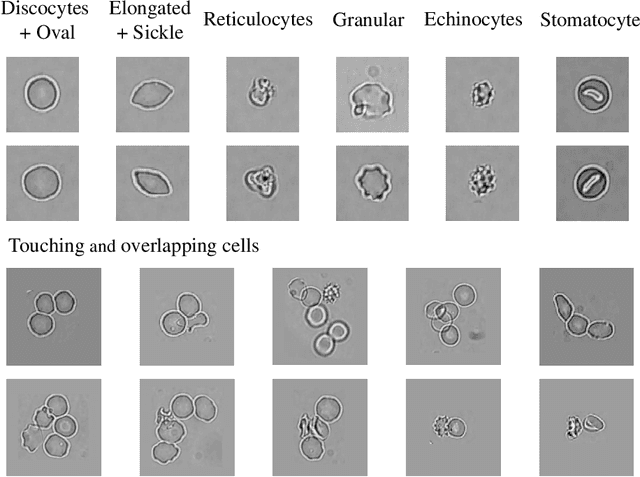


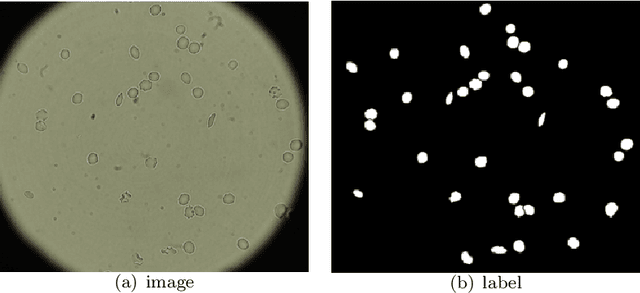
Abstract:Cell detection and cell type classification from biomedical images play an important role for high-throughput imaging and various clinical application. While classification of single cell sample can be performed with standard computer vision and machine learning methods, analysis of multi-label samples (region containing congregating cells) is more challenging, as separation of individual cells can be difficult (e.g. touching cells) or even impossible (e.g. overlapping cells). As multi-instance images are common in analyzing Red Blood Cell (RBC) for Sickle Cell Disease (SCD) diagnosis, we develop and implement a multi-instance cell detection and classification framework to address this challenge. The framework firstly trains a region proposal model based on Region-based Convolutional Network (RCNN) to obtain bounding-boxes of regions potentially containing single or multiple cells from input microscopic images, which are extracted as image patches. High-level image features are then calculated from image patches through a pre-trained Convolutional Neural Network (CNN) with ResNet-50 structure. Using these image features inputs, six networks are then trained to make multi-label prediction of whether a given patch contains cells belonging to a specific cell type. As the six networks are trained with image patches consisting of both individual cells and touching/overlapping cells, they can effectively recognize cell types that are presented in multi-instance image samples. Finally, for the purpose of SCD testing, we train another machine learning classifier to predict whether the given image patch contains abnormal cell type based on outputs from the six networks. Testing result of the proposed framework shows that it can achieve good performance in automatic cell detection and classification.
 Add to Chrome
Add to Chrome Add to Firefox
Add to Firefox Add to Edge
Add to Edge